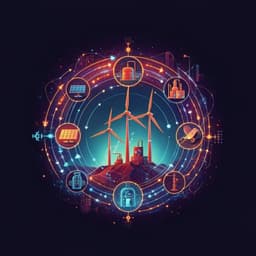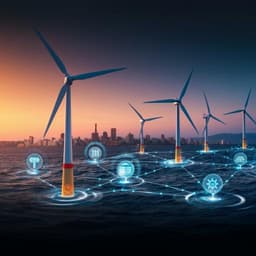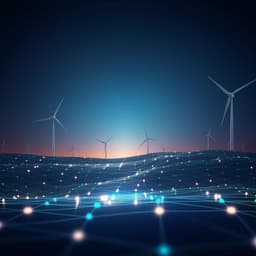
Environmental Studies and Forestry
Energy systems in scenarios at net-zero CO<sub>2</sub> emissions
J. Deangelo, I. Azevedo, et al.
This study delves into 177 net-zero emission scenarios, revealing that renewable energy sources constitute 60% of primary energy at net-zero. Conducted by Julianne DeAngelo, Inês Azevedo, John Bistline, Leon Clarke, Gunnar Luderer, Edward Byers, and Steven J. Davis, it uncovers the uneven distribution of emissions across regions, raising critical questions about equity in burden-sharing.
~3 min • Beginner • English
Introduction
Limiting global mean temperature increase to 2 °C or 1.5 °C relative to preindustrial levels requires global CO2 emissions to reach net-zero or net-negative by late century, potentially as early as 2050. Because warming is proportional to cumulative CO2, any additional emissions increase future warming, making net-zero a clear policy target. Achieving this goal necessitates rapid energy system transformations—deep reductions in fossil fuel use, major efficiency gains, extensive end-use electrification, and carbon management—while aligning with sustainable development and accounting for inertia in existing fossil infrastructure. While prior work has explored mitigation pathways and sectoral transformations using integrated assessment models (IAMs), the shared characteristics and tradeoffs at the moment global CO2 reaches net-zero have not been systematically assessed. This study analyzes 177 scenarios from the IPCC SR1.5 database that attain global net-zero CO2 by 2100, characterizing energy use, sources, electrification, residual and negative emissions, and policy signals to inform net-zero strategies.
Literature Review
The paper situates its analysis within a growing body of work on net-zero energy systems and IAM-based mitigation pathways. Studies have examined challenges and opportunities for net-zero, detailed analyses of technologies and services (e.g., electrification, long-duration storage, BECCS), and 1.5 °C pathways in IAMs, yielding insights into energy-economy-land transformations. However, a gap remains regarding systematic evaluation of energy system attributes at the point of global net-zero CO2. Prior work also highlights residual fossil CO2 in 1.5–2 °C pathways, the role and feasibility concerns of negative emissions technologies, possible underestimation of variable renewables in IAMs, and equity considerations in allocating negative emissions. This study builds on these strands by comparing common features across a large ensemble at net-zero.
Methodology
Data: 177 scenarios were drawn from the public IPCC SR1.5 Scenario Database (IIASA IAMC; version r2.0, all regions dataset), produced by 7 main IAMs (16 variants). Scenarios include those that reach global net-zero CO2 by 2100. Models are process-based IAMs using cost-effectiveness approaches and operate at 5–10 year timesteps across macro-regions.
Processing: The net-zero year is defined as the first year when global net CO2 ≤ 0, with annual values interpolated using second-order polynomials. Only CO2 is considered (not CH4 or N2O), aligning with policy targets and focusing on energy system emissions; AFOLU CO2 is included where relevant. Scenarios are categorized into 3 end-of-century warming groups: <1.5 °C (including overshoot variants), <2.0 °C, and >2.0 °C (likely >50% chance of exceeding 2 °C by 2100). Regional analysis uses five macro-regions: Asia, Latin America, Middle East + Africa, OECD + EU, and Eastern Europe + Russia, plus Global.
Variables analyzed: (1) CO2 emissions (total net; energy and industrial processes net; AFOLU net), (2) population, (3) GDP (PPP), (4) primary energy (direct equivalent) by source (fossil, nuclear, solar, wind, hydro, biomass), (5) carbon sequestration via BECCS, (6) carbon price, and (7) final energy (total and electricity share). Residual emissions were computed by combining energy/industrial emissions with BECCS and, where applicable, AFOLU terms, to reflect emissions requiring offset at net-zero. Statistical analyses include medians, ranges, correlations, and ANOVA across warming groups; relationships among scenario characteristics are assessed using standardized values and pairwise correlations.
Key Findings
- Timing and scale: Across 177 scenarios, the median net-zero year is 2064 (range 2037–2100). Peak emissions occur nearly immediately across groups: 2017 (1.5 °C; range 2014–2027), 2019 (2 °C; 2011–2029), and 2022 (>2 °C; 2010–2036).
- Energy use and GDP: Scenarios limiting warming to 1.5 °C have lower final energy and GDP per capita at net-zero than warmer scenarios. For 1.5 °C scenarios (n=77), GDP per capita is < $40k in 91% (median $27,914; range $20,103–$58,506) and final energy < 500 EJ in 69% (median 439 EJ; range 227–646). For 2 °C and >2 °C scenarios (n=100), GDP per capita < $40k in 43% (median $43,642; range $20,299–$116,666) and final energy < 500 EJ in 24% (median 580 EJ; range 345–857).
- Energy sources at net-zero: Renewables provide a median ~60% of primary energy (range ~25–80%) with about half of renewable supply from non-biomass sources (median ~55%; range 20–89%). Fossil fuels still provide a median 33% of primary energy (range 3–64%), with any residual emissions offset by negative emissions. Nuclear contributions are generally modest (median 4.8%; max 23.4%).
- Residual emissions: Emissions intensity of final energy remains significant in many scenarios (>30 Mt CO2/EJ vs ~80 Mt CO2/EJ today), largely independent of warming level. Many scenarios have >10 Gt CO2 residuals in the net-zero year requiring offset.
- Electrification: Electricity comprises 35–80% of final energy across scenarios, with medians by warming group of 46% (1.5 °C), 51% (2 °C), and 53% (>2 °C). Later net-zero years correlate with higher electrification (r=0.27, p<0.001), reflecting more time for end-use transition. However, limiting final energy demand is more strongly associated with lower warming (median per-capita final energy rises from 47 to 63 to 75 GJ/person across the warming groups).
- Policy and BECCS: Carbon prices range from $0 to >$1000/tCO2 (16 scenarios >$2000/tCO2), with no clear relationship to warming level or BECCS deployment; most prices are endogenous shadow prices. Median BECCS sequestration increases with warming: 6.4 Gt CO2 (1.5 °C; range 0–16.7), 8.0 Gt (2 °C; 0–18.8), 11.3 Gt (>2 °C; 3.7–16.4) in the net-zero year.
- Regional patterns: At global net-zero, Asia and OECD+EU have the highest total final energy; OECD+EU has highest median GDP per capita (~$67,944), while Middle East + Africa is lowest (~$18,960). Latin America shows higher renewable shares (median 80% of primary energy; range 33–98%) and a larger biomass share within renewables (median 58%). Electrification medians vary modestly across regions (43–52%). Residual emissions per capita are highest in Eastern Europe + Russia (median 1.9 t CO2/person; range 0.1–5.2) and OECD+EU (1.8; 0.2–4.9). Latin America’s energy system is net-negative in 78.1% of scenarios; Middle East + Africa and Asia are net-negative in 14.0% and 19.4%, respectively.
- Global residual vs negative emissions: Warmer scenarios feature higher residual emissions, less negative land-use CO2, and greater BECCS. In >2 °C scenarios, BECCS averages 10.5 Gt CO2 in the net-zero year (minimum 3.7 Gt). Some 1.5 °C and <2.0 °C scenarios require no BECCS due to larger land-use negative emissions. In 40 scenarios with sectoral detail, transport is the dominant residual emissions source.
- Cross-characteristic relationships: Higher electrification correlates with higher renewable and non-biomass renewable shares (r≈0.64 and 0.59) and with higher per-capita energy use (lower conservation; r≈-0.35). Greater energy conservation correlates with lower non-biomass renewable shares (r≈-0.46). BECCS magnitude shows weaker, model-dependent associations.
Discussion
Findings indicate that, at the point of global net-zero CO2, energy systems still rely substantially on non-electric fuels, particularly in hard-to-electrify sectors (construction, agriculture, aviation, shipping). While electrification expands to roughly half of final energy, the level of final energy demand is a stronger differentiator for achieving lower warming: 1.5 °C-consistent scenarios generally feature lower per-capita energy use. Residual emissions remain sizable in many scenarios, necessitating large-scale negative emissions, especially BECCS in warmer cases. The uneven regional distribution of residual and negative emissions—e.g., Latin America often providing net negative emissions while other regions retain net-positive energy-system emissions—raises equity and burden-sharing considerations. Relationships among scenario attributes suggest tradeoffs: higher electrification aligns with greater renewable deployment but also with higher per-capita final energy in many scenarios; higher energy conservation associates with lower non-biomass renewable shares in the modeled cost-effective portfolios. Policy implications include prioritizing measures that reduce residual emissions (to limit future dependency on large negative emissions), managing energy demand, and developing carbon-neutral fuels and enabling technologies for hard-to-electrify uses. The results should be interpreted in light of IAM assumptions and optimization of least-cost pathways across large regions.
Conclusion
The study systematically characterizes energy systems at the point of global net-zero CO2 across 177 IAM scenarios. Common features include: renewables supplying about 60% of primary energy (with substantial biomass), electricity providing roughly half of final energy, and persistent residual emissions requiring significant negative emissions—especially in warmer scenarios. Regional asymmetries in residual and negative emissions highlight equity and burden-sharing challenges. Policy-relevant insights emphasize the importance of limiting final energy demand, accelerating end-use transitions and carbon-neutral fuels, and reducing residual emissions to curb reliance on negative emissions. Future research should improve IAM representations of carbon-neutral fuels, long-duration storage, variable renewables, and negative emissions strategies; explore equitable allocation of residual and negative emissions; and assess updated AR6 scenarios and detailed sectoral dynamics.
Limitations
- Scenario ensemble is not a representative probabilistic sample; scenarios are equally plausible within model constraints and reflect model-specific assumptions.
- IAM limitations: relatively coarse temporal/spatial/technological resolution; potential underestimation of variable renewables’ role; simplified treatment of grid integration and disruptive technologies; exclusion of climate impact/damage feedbacks.
- Focus on CO2 only (excluding CH4 and N2O) and on energy-system characteristics; residual sectoral detail limited in many scenarios.
- Many carbon prices are endogenous shadow prices, limiting direct policy comparability.
- Some scenarios assume earlier peak emissions than observed historically; outputs depend on model structures and scenario constraints; missing variables in some models reduced the analyzable set to 177 of 202 net-zero scenarios.
Related Publications
Explore these studies to deepen your understanding of the subject.







